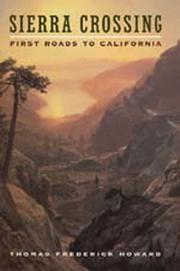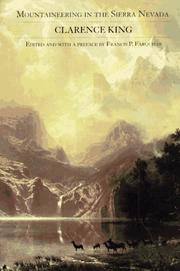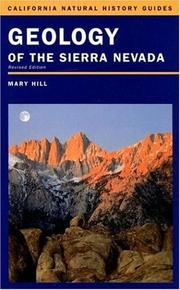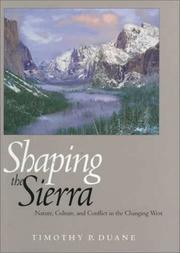| Listing 1 - 6 of 6 |
Sort by
|

ISBN: 0874177170 9780874177176 9780874177008 0874177006 Year: 2007 Publisher: Reno, Nevada ; Las Vegas, [Nevada] : University of Nevada Press,
Abstract | Keywords | Export | Availability | Bookmark
 Loading...
Loading...Choose an application
- Reference Manager
- EndNote
- RefWorks (Direct export to RefWorks)

ISBN: 0520926218 0585116687 9780520926219 9780585116686 0520206703 Year: 1998 Publisher: Berkeley : University of California Press,
Abstract | Keywords | Export | Availability | Bookmark
 Loading...
Loading...Choose an application
- Reference Manager
- EndNote
- RefWorks (Direct export to RefWorks)
A critical era in California's history and development-the building of the first roads over the Sierra Nevada-is thoroughly and colorfully documented in Thomas Howard's fascinating book. During California's first two decades of statehood (1850-1870), the state was separated from the east coast by a sea journey of at least six weeks. Although Californians expected to be connected with the other states by railroad soon after the 1849 Gold Rush, almost twenty years elapsed before this occurred. Meanwhile, various overland road ventures were launched by "emigrants," former gold miners, state government officials, the War Department, the Interior Department, local politicians, town businessmen, stagecoach operators, and other entrepreneurs whose alliances with one another were constantly shifting. The broad landscape of international affairs is also a part of Howard's story.Constructing roads and accumulating geographic information in the Sierra Nevada reflected Washington's interest in securing the vast western territories formerly held by others. In a remarkably short time the Sierra was transformed by vigorous exploration, road-promotion, and road-building. Ox-drawn wagons gave way to stagecoaches able to provide service as fine as any in the country. Howard effectively uses diaries, letters, newspaper stories, and official reports to recreate the human struggle and excitement involved in building the first trans-Sierra roads. Some of those roads have become modern highways used by thousands every day, while others are now only dim traces in the lonely backcountry.
Roads --- Overland journeys to the Pacific. --- Overland journeys to the Pacific --- Business & Economics --- Transportation Economics --- Transcontinental journeys (United States) --- Travels --- Frontier and pioneer life --- Voyages and travels --- Highways --- Roadways --- Thoroughfares --- Transportation --- Highway engineering --- Pavements --- History --- Sierra Nevada (Calif. and Nev.) --- Sierra Nevada Mountains (Calif. and Nev.) --- Sierra Nevada Range (Calif. and Nev.) --- Sierras (Calif. and Nev.) --- Description and travel.

ISBN: 0585274320 9780585274324 0803277830 9780803277830 9783736419568 3736419562 Year: 1997 Publisher: Lincoln University of Nebraska Press
Abstract | Keywords | Export | Availability | Bookmark
 Loading...
Loading...Choose an application
- Reference Manager
- EndNote
- RefWorks (Direct export to RefWorks)
A bona fide classic, originally published in 1872, Mountaineering in the Sierra Nevada is still exciting reading. It describes the perils and pleasures experienced by Clarence King (1842-1901) while conducting the first geological survey of California in the 1860s. His language was equal to the marvels he found, and here with unfading brilliance are his accounts of scaling such mountains as Tyndall, Shasta, and Whitney. The chapters on the Yosemite Valley and surrounding High Sierras were written while he was surveying the boundaries of a newly designated national park. There are also delightful vignettes of western characters, including a Sierra artist and a family of Pike County hog farmers. King, who in 1879 became the first director of the United States Geological Survey, will always be remembered for Mountaineering in the Sierra Nevada, which was praised by Wallace Stegner, Van Wyck Brooks, and Henry Seidel Canby as a watermark of frontier literature.
Mountaineering --- United States Local History --- Regions & Countries - Americas --- History & Archaeology --- Climbing mountains --- Mountain climbing --- Hiking --- Outdoor life --- King, Clarence, --- Todd, James, --- Journeys --- Travel --- Sierra Nevada (Calif. and Nev.) --- Sierra Nevada Mountains (Calif. and Nev.) --- Sierra Nevada Range (Calif. and Nev.) --- Sierras (Calif. and Nev.) --- Description and travel.

ISBN: 9780520936942 9786612762833 0520936949 0520236955 9780520236950 0520236963 9780520236967 1282762834 Year: 2006 Publisher: Berkeley : University of California Press,
Abstract | Keywords | Export | Availability | Bookmark
 Loading...
Loading...Choose an application
- Reference Manager
- EndNote
- RefWorks (Direct export to RefWorks)
Writing with verve and clarity, Mary Hill tells the story of the magnificent Sierra Nevada-the longest, highest, and most spectacular mountain range in the contiguous United States. Hill takes us from the time before the land which would be California even existed, through the days of roaring volcanoes, violent earthquakes, and chilling ice sheets, to the more recent history of the Sierra's early explorers and the generations of adventuresome souls who followed. The author introduces the rocks of the Sierra Nevada, which tell the mountains' tale, and explains how nature's forces, such as volcanic eruptions, earthquakes, faulting, erosion, and glaciation formed the range's world-renowned scenery and mineral wealth, including gold. For thirty years, the first edition of Geology of the Sierra Nevada has been the definitive guide to the Sierra Nevada's geological history for nature lovers, travelers, hikers, campers, and armchair explorers. This new edition offers new chapters and sidebars and incorporates the concept of plate tectonics throughout the text. * Written in easy-to-understand language for a wide audience. * Gives detailed information on where to view outstanding Sierra Nevada geology in some of the world's most beloved natural treasures and national parks, including Yosemite. * Provides specific information on places to see glaciers and glacial deposits, caves, and exhibits of gold mines and mining equipment, many from Gold Rush times. * Superbly illustrated with 117 new color illustrations, 16 halftones, 39 line illustrations, and 12 maps, and also features an easy-to-use, interactive key for identifying rocks and a glossary of geological terms.
Geology --- Geognosy --- Geoscience --- Earth sciences --- Natural history --- Sierra Nevada (Calif. and Nev.) --- Sierra Nevada Mountains (Calif. and Nev.) --- Sierra Nevada Range (Calif. and Nev.) --- Sierras (Calif. and Nev.) --- Geology -- Sierra Nevada (Calif. and Nev.). --- Sierra Nevada (Calif. and Nev.). --- california. --- campers. --- earth sciences. --- earthquakes. --- easy to read. --- erosion. --- field guide. --- geologists. --- geology textbooks. --- glaciation. --- gold rush. --- gold. --- hikers. --- illustrated. --- maps. --- mineral deposits. --- mountain range. --- national parks. --- natural forces. --- natural history. --- natural sciences. --- natural world. --- nature lovers. --- nonfiction. --- plate tectonics. --- regional geology. --- regional history. --- rock science. --- scientists. --- sierra nevada. --- travel guide. --- travelers. --- united states. --- volcanic regions. --- yosemite.

ISBN: 128235616X 9786612356162 0520926145 9780520926141 0520212460 0520226763 9780520226760 9780520212466 Year: 1999 Publisher: Berkeley, CA : University of California Press,
Abstract | Keywords | Export | Availability | Bookmark
 Loading...
Loading...Choose an application
- Reference Manager
- EndNote
- RefWorks (Direct export to RefWorks)
The rural west is at a crossroads, and the Sierra Nevada is at the center of this social and economic change. The Sierra Nevada landscape has always been valued for its bounty of natural resource commodities, but new residents and an ever-growing flood of tourists to the area have transformed the relationship between the region's nature and its culture. In an engaging narrative that melds the personal with the professional, Timothy P. Duane-who grew up in the area-documents the impact of rapid population growth on the culture, economy, and ecology of the Sierra Nevada since the late 1960's. He also recommends innovative policies for mitigating the negative effects of future population growth in this spectacular but threatened region, as well as throughout the rural west. Today, the primary social and economic values of the Sierra Nevada landscape are in the amenities and ecological services provided by its wildlands and functioning ecosystems. Duane shows how further unfettered population growth threatens the very values which have made the Sierra Nevada a desirable place to live and work. A new approach to land use planning, resource management, and local economic development-one that recognizes the emerging values of the landscape-is necessary in order to achieve sustainable development, Duane claims. Weaving personal experience with outstanding scholarship, he shows how such an approach must explicitly recognize the importance of values and the application of an environmental land ethic to future development in the area.
Environmental policy -- Sierra Nevada (Calif. and Nev.). --- Environmental policy -- West (U.S.). --- Sierra Nevada (Calif. and Nev.) -- Environmental conditions. --- Sierra Nevada (Calif. and Nev.) -- Population. --- Sustainable development -- Sierra Nevada (Calif. and Nev.). --- West (U.S.) -- Population. --- Environmental policy --- Sustainable development --- Environmental Sciences --- Earth & Environmental Sciences --- Development, Sustainable --- Ecologically sustainable development --- Economic development, Sustainable --- Economic sustainability --- ESD (Ecologically sustainable development) --- Smart growth --- Sustainable economic development --- Economic development --- Environment and state --- Environmental control --- Environmental management --- Environmental protection --- Environmental quality --- State and environment --- Environmental auditing --- Environmental aspects --- Government policy --- Sierra Nevada (Calif. and Nev.) --- West (U.S.) --- American West --- Trans-Mississippi West (U.S.) --- United States, Western --- Western States (U.S.) --- Western United States --- Sierra Nevada Mountains (Calif. and Nev.) --- Sierra Nevada Range (Calif. and Nev.) --- Sierras (Calif. and Nev.) --- Environmental conditions. --- Population. --- E-books
Book
ISBN: 0520964233 9780520964235 9780520289642 Year: 2017 Publisher: Berkeley, CA : University of California Press,
Abstract | Keywords | Export | Availability | Bookmark
 Loading...
Loading...Choose an application
- Reference Manager
- EndNote
- RefWorks (Direct export to RefWorks)
From ski towns to national parks, fresh fruit to environmental lawsuits, the Sierra Nevada has changed the way Americans live. Whether and where there was gold to be mined redefined land, mineral, and water laws. Where rain falls (and where it doesn't) determines whose fruit grows on trees and whose appears on slot machines. All this emerges from the geology of the range and how it changed history, and in so doing, changed the country. The Mountains That Remade America combines geology with history to show how the particular forces and conditions that created the Sierra Nevada have effected broad outcomes and influenced daily life in the United States in the past and how they continue to do so today. Drawing connections between events in historical geology and contemporary society, Craig H. Jones makes geological science accessible and shows the vast impact this mountain range has had on the American West.
Geology --- Human geography --- Mountains --- Gold mines and mining --- Gold discoveries --- Gold extraction (Mining) --- Gold fields --- Gold mining --- Gold rush --- Gold rushes --- Goldfields --- Goldmining --- Goldrush --- Goldrushes --- Sites, Gold mining --- Mines and mineral resources --- Hills --- Mountain peaks --- Mountain ranges --- Mountain ridges --- Mounts (Mountains) --- Orography --- Orology --- Peaks --- Pinnacles --- Ranges, Mountain --- Ridges, Mountain --- Summits (Mountains) --- Uplands --- Anthropo-geography --- Anthropogeography --- Geographical distribution of humans --- Social geography --- Anthropology --- Geography --- Human ecology --- Geognosy --- Geoscience --- Earth sciences --- Natural history --- History. --- Sierra Nevada (Calif. and Nev.) --- Sierra Nevada Mountains (Calif. and Nev.) --- Sierra Nevada Range (Calif. and Nev.) --- Sierras (Calif. and Nev.) --- american landscape. --- american west. --- backpacker. --- cartographer. --- contemporary society. --- geographer. --- geography. --- geological science. --- geologist. --- geology. --- hiker. --- historical geology. --- mountain range. --- natural science. --- outdoorsman. --- sierra nevada mountains. --- travel guide.
| Listing 1 - 6 of 6 |
Sort by
|

 Search
Search Feedback
Feedback About
About Help
Help News
News